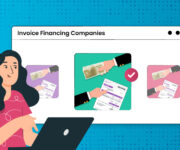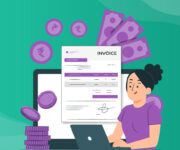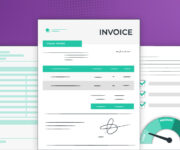The lack of credit is one of the biggest challenges facing India’s Micro Small and Medium Enterprises (MSME), which represent a lucrative market for banks and NBFCs.
A study conducted by IFC Intellecap in June 2019 revealed that 80% of India’s 55.8 million MSMEs, in both the manufacturing and service sectors, were in dire need of business finance. The gap between demand and supply is estimated to be as high as $400 billion or INR 16.66 lakh crore, a figure that has doubled since 2012.
Here Are The Reasons That Caused Small Businesses To Fall Back On Invoice Financing

Effects of Liquidity Crunch
From a small business owner’s perspective, poor cash flow is a challenge that has serious implications for survival. It is one of the main reasons why small businesses need to borrow. Since offering credit periods of 30-90 days is a must for making sales, MSMEs often fall short of working capital. In the current economic scenario, the overall contraction in demand is only making matters worse.
The impact of demonetization is still being felt by small businesses with borrowings of less than INR 10 lakh, as per a study conducted jointly by TransUnion CIBIL and SIDBI. Though digital banking has since been adopted on a large scale, the liquidity crunch it caused forced businesses to look at alternative options for getting funding.
The Slowdown of the Business Cycle
Sales bring in revenue for businesses, which enables them to sustain and expand operations on an on-going basis. However, with several key industrial sectors in decline, small businesses have been deprived of much-needed revenues. As large companies cut production due to declining sales, MSMEs working on projects outsourced by them are also suffering.
The absence of a long term investment in infrastructures such as highways, ports, and Special Economic Zones (SEZ) is also to blame. For a country that aspires to become a $5 trillion economy by 2025, this situation is increasingly making small Indian businesses less competitive compared to their foreign counterparts.
Resistance to Change
The traditional mindset of some MSMEs in semi-urban and rural areas is also partly responsible for the credit problems faced by them. According to a study conducted by Instamojo, up to 49% of small business owners continue to rely on traditional sources of capital, such as borrowing from friends and family, pawnbrokers, etc. The general lack of awareness about government schemes and GST norms further compounds problems
This puts pressure on entrepreneurs to scale down their operations or to refinance their existing debts by mortgaging other assets, adding to their debt burden.
Higher Credit Risk for Banks

While India’s position has consistently improved on the World Bank’s Ease of Doing Business Index, liquidity remains a problem as a large number of small traders and retailers lack proper financial records and have little business experience, which makes lending to them a risky proposition.
Banks are often unable to establish whether such businesses are creditworthy. Owners are ultimately forced to rely on their personal assets to arrange collateral. Fortunately, MSME has been identified by the government as a ‘priority sector’, and documentation requirements for business loans are being simplified.
Loans under the MUDRA scheme, for example, require applicants to provide information regarding KYC and proof of ownership. However, with the current liquidity crisis in the NBFC sector, the risk of increased Non-Performing Assets (NPA) has made lenders cautious.
These factors have caused small businesses to fall back on alternatives such as Invoice Financing to make up for shortfalls in the capital.
Is Invoice Financing a Good Solution for MSMEs?
For short term working capital needs, invoice financing offers small businesses a viable solution in an uncertain business environment. It allows them to endorse bills receivable to a lender – a bank or NBFC – to meet operating expenses or for expansion. During peak business cycles, Invoice Financing can help MSMEs buy inventory, hire additional workers, and handle higher production volumes, providing much- needed cash within 24-48 hours.
Depending on the borrower’s preferences, invoices can either be discounted or factored. With discounting, the MSME raising the invoice is responsible for claiming payment from its customer and repaying the lender. This requires the seller to follow-up with creditors.
On the other hand, factoring transfers the ownership of the unpaid invoice to the lender, which, in turn, assumes responsibility for collecting on it. Invoice Financing offers small businesses the following advantages:
Fast and efficient:

Invoice Financing is ideal to meet short term working capital requirements as the funds are disbursed within 1-2 working days, once the bill is discounted. This gives MSMEs access to much-needed funds quickly, allowing it to meet day to day expenses such as paying salaries, buying raw material, and also to bid aggressively for new projects.
No collateral required:
One of the biggest hurdles faced by new MSMEs is the lack of collateral. Since a typical business cycle for most small businesses usually lasts for 90-120 days, invoice discounting leverages the invoice as collateral to provide short term finance for businesses.
No interest payable:
Unlike traditional options such as business loans, Invoice Financing does not work on the principle of interest. Lenders charge a fixed percentage of the realized invoice as a fee for their services. Peer to peer lending platforms charges a commission from both parties to an invoice.
No impact on credit score:
One of the biggest advantages of Invoice Financing is that the personal credit score of a sole proprietor or principal of a partnership firm is not considered. As the underlying transaction is a sale and not debt, lenders check the face value of the collateral i.e. the invoice. In contrast, a bank loan constitutes a secured debt, for which the owner’s credit history is considered.
Transfer of liability:
In case of bill factoring, the liability of the MSME ends as soon as it hands over the invoice to the factoring institution. The bank assumes the responsibility of collecting payment directly from the buyer of goods.
On the other hand, with invoice factoring, the borrower retains liability for collecting the amount owed and paying the lender. It remains vulnerable to risks such as bad debt, recovery hassles and litigation.
While Invoice Financing is popular with early-stage start-ups and small companies, it suffers from a number of misconceptions, particularly with regards to the margin. With the arrival of digital banking solutions, the utility of Invoice Financing for businesses has only increased. Let’s unravel some of the most common myths surrounding Invoice Financing solutions:
Customer dissatisfaction:
- Myth
Some companies worry that lenders may contact their customers as part of the due diligence process before issuing credit. They fear that this could impact client relationships and potentially affect future business from the same account.
- Fact
While it is true that the lender may verify the invoice with the buyer, the exact process followed by them varies widely. It is advisable to contact the bank to check how the verification process works and if possible, reach out to the customer to let them know what to expect.
Prepayment fees:
- Myth
It is a common misconception that in case a discounted or factored invoice is paid before the due date under the credit terms, the lender pockets any leftover amount as prepayment fees. Some business owners feel that such prepayment fees are arbitrary and the borrower has no say in it.
- Fact
Contrary to this misplaced notion, NBFCs and banks do not charge any fees for prepayment. There are two reasons for this. Firstly, lenders do not lose out on future interest in case of invoice based financing. Secondly, a borrower is unlikely to withdraw a surrendered invoice as it would defeat the purpose of obtaining cash quickly.
Repossession of goods in case of default
- Myth
Many small business owners believe that if a factored invoice is not honoured by the buyer within the credit period, the bank can legally confiscate the goods sold. They fear to have to fight legal battles in court to reclaim the goods under a three-way dispute involving the bank and the buyer.
- Fact
Once the seller endorses the invoice to the factoring bank, it relinquishes its right over the goods sold. In other words, if the seller defaults on paying the factored invoice, the original seller is not legally responsible for enforcing the contract. The seller is thus indemnified from the consequences of non-payment.
Invoice Financing is expensive
- Myth
MSMEs often forgo Invoice Financing because of its perceived high cost. They instead try to meet their short term working capital needs by borrowing from friends or family. Some think that if a bill is discounted at 80% of its face value, the lender becomes entitled to the remaining 20% in its entirety.
- Fact
The cost of business financing must always be viewed in relation to the need. If the seller needs funds within 1-2 days of invoicing, Invoice Financing is cheaper compared to a business credit card. However, it is important to assess whether your profit margin on the transaction is large enough to cover the cost of Invoice Financing.
Is Invoice Financing a Good Solution for Lenders?

B2B lending offers higher profit margins for lending agencies, depending on the credentials of the borrower. As MSMEs constitute more than 95% of all business entities in India, the relative transaction sizes – compared to consumer lending – are much bigger.
With the government actively encouraging banks to increase loans to small businesses and start-ups, NBFCs and HFCs are assured, at least theoretically, of policy support in case of losses. Over the last few years, the use of integrated loan lifecycle management tools like Finezza has become widespread, peer to peer lending platforms and NBFCs improved credit evaluation capabilities which ultimately helps them tap into newer markets, over the long term.
Finezza’s loan eligibility estimator and credit bureau data analysis algorithms let lenders make sound lending decisions and reduce their exposure to potential NPAs. It increases the quality of decision making and helps them realistically forecast revenue growth and risk exposure.
Here are some of the other advantages of Invoice Financing that lenders should look to capitalize on:
Good quality credit
High growth start-ups and small businesses dealing in premium products and services usually have high creditworthiness. Due to extended billing cycles, they routinely turn to banks and NBFCs for borrowing short term capital against unpaid invoices. This reduces the credit risk exposure of banks, as returns are more or less assured.
Higher returns
Compared to alternatives like business cash advance or overdraft, Invoice Financing offers better returns on investment for lenders. This helps to stabilize them, stabilize their portfolios and acts as a hedge against losses on long term debts. With automated loan management tools like Finezza, Fintech companies such as invoice financing platforms can earn significant margins on the funding they provide MSMEs and corporate clients.
Diversification
Banks facing fiscal stress due to dropping revenues find Invoice Financing ideal to diversify their lending portfolios and boost bottom lines in the short term. As a profitable B2B niche, Invoice Financing reduces the risk of market volatility across different product lines.
Economies of scale
With the help of automated loan management systems like Finezza, lenders can approve loans against discounted or factored invoices faster. They can generate economies of scale when borrowers pledge multiple invoices, reducing operating costs and turn around times, increasing overall efficiency.
Technology
Evaluating credit risk in a dynamic lending environment can be challenging. Decision support engines embedded in the latest loan management systems can automatically identify risk triggers and derive the right insights from customer data. For example, Finezza’s Bank Statement Analysis Algorithm helps lenders build accurate predictive models, reducing errors.
Conclusion
Finding the right solution for short term capital needs can help MSMEs become more competitive. Invoice Financing helps them avoid hurdles such as lack of collateral and credit history. For lending companies, invoice based financing is ideal for growing market share and overcoming volatility.
To know more about Finezza, get in touch with us!




Leave a Reply